Hooking-up to the mains
Connecting your caravan or motorhome to a campsite’s electric hook-up point will give you an instant supply of electricity into your home on wheels. Here we bring you all you need to know about electric hook-ups when on site…
All modern caravans and motorhomes should be supplied with a 25-metre flexible cable (usually orange, so that it can be seen in the grass to avoid people tripping over it) with pre-fitted 3-pin blue connectors suitable for UK sites. They should be compliant with BS EN 60309-2.
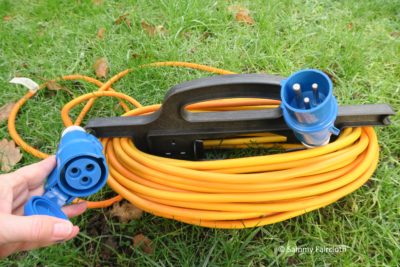
All modern caravans and motorhomes should be supplied with a 25-metre flexible cable
Follow these simple steps to make sure you hook-up safely when on site:
- Turn off all the switches and appliances in your caravan or motorhome. As a safety precaution, locate the mains consumer unit and turn off all the switches on that as well.
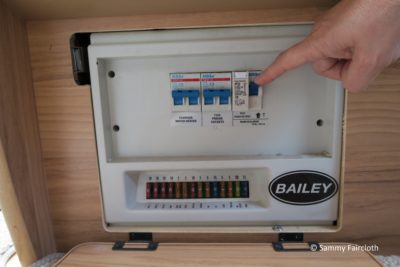
As a safety precaution, turn off all the switches on the mains consumer unit before hooking-up.
- Unwind your hook-up cable fully in order to prevent the cable overheating and potentially catching fire. If your cable is damaged in any way, replace it. Do not put tape around it or put in a polythene bag – condensation might form.
- Insert the supply plug (the female end) into the mains inlet that’s fitted on the outside wall of your caravan or motorhome. For safety reasons, the plug has recessed tubes rather than projecting pins.
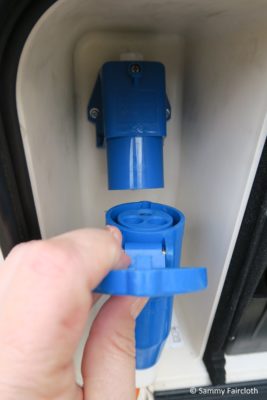
Connect the female end of the blue connector to the caravan or motorhome’s mains inlet
- Unravel the cable, making sure there are no projecting loops which could trip someone up. Now insert the plug at the other end of the cable (the male end) into the site’s hook up point.
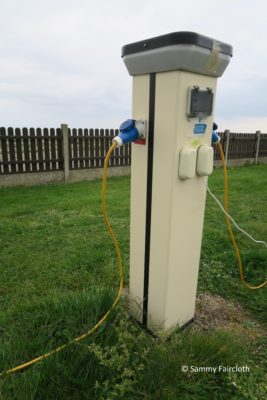
Insert the male end of the blue connector to the hook-up point
- Lay any excess cable under your caravan/motorhome in large, loose coils.
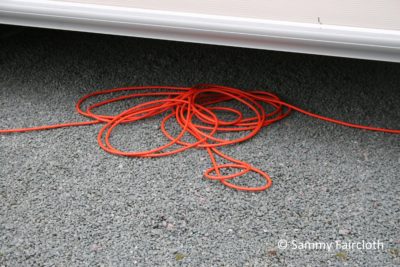
Lay any excess cable under your caravan/motorhome in large, loose coils to avoid the cable overheating.
- Normally the current will now be flowing to the consumer unit in your leisure vehicle.
- At this stage, you go back into your caravan or motorhome, and flick the consumer unit’s switches to their ON position. Next, carry out a safety check by pressing the test button to confirm that the master switch “trips out” – as it should if anything goes wrong. If it does this promptly (as it should) then turn the switch on again so that the supply is ready for use.
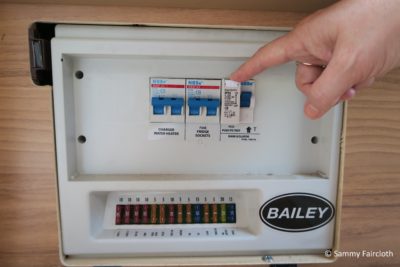
Carry out a safety check by pressing the test button on the mains consumer to confirm that the master switch “trips out” – as it should if anything goes wrong.
- The next task is to insert a mains tester into a 13 Amp socket to check that there isn’t a case of reversed polarity. This term means that the site system has somehow got wired the wrong way around with the neutral and live cables incorrectly swapped over. That’s potentially dangerous so it’s best to go without a mains supply if this condition is revealed on the tester. In reality, it’s very unlikely in the UK, but reversed polarity is occasionally found on the continent.
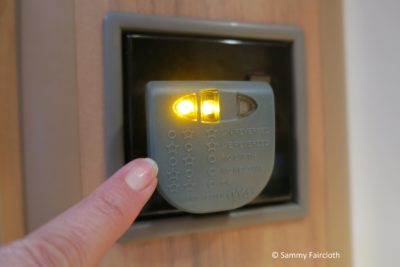
Carry out a reversed polarity check using a mains tester plugged into a 13 amp socket.
UK electric hook-ups
Most sites in the UK supply a maximum of 16 amps. The ampere (amps) rating on the hook-up refers to the amount of current available.
If staying on a temporary pitch or attending a rally the amps tend to be lower (more like six amps), so check before hooking up.
Most electric hook-up points in the UK are simple to connect to by simply plugging straight in. However, on a few sites you’ll find that the plug in the hook-up pillar has to be rotated clockwise and released to complete the connection. These versions are easy to identify because they also have a red push button which has to be pressed when you later want to disconnect the plug.
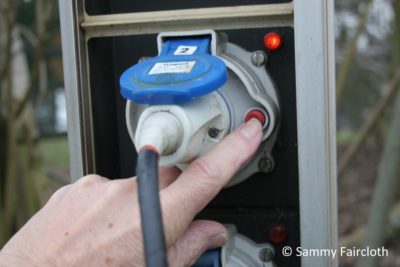
Some UK hook-up points have a red push button which has to be pressed when you want to disconnect the plug.
European electric hook-ups
European electric hook-up points look similar to the UK’s, but some countries, like France and Germany, use a two-pin connector.
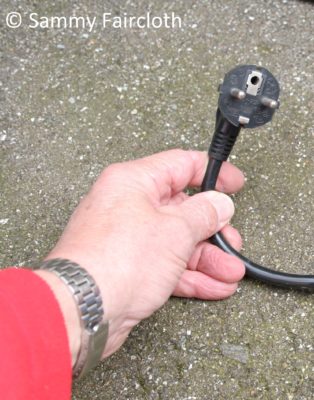
Europeans tend to use two pin plugs.
Simply buy an adaptor as a back-up before going on your travels.
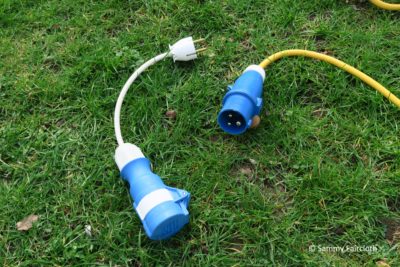
Buy a plug adapter if travelling in Europe.
The amount of current available at a hook-up point can vary considerably from between three and 20 amps In Europe. It’s not uncommon for the electricity supply in the Netherlands to vary between four and 10 amps.
Some countries like Germany and Austria have metered hook-up units or charge a daily rate, particularly during the ski season. Always check before booking, otherwise, you might get a shock when you receive your final invoice.
Sometimes a 25-metre cable is not long enough to reach the electric hook-up point on some French sites so it’s worth carrying a spare 10-metre cable and a weatherproof plug and coupler safebox – just in case you need extra length.
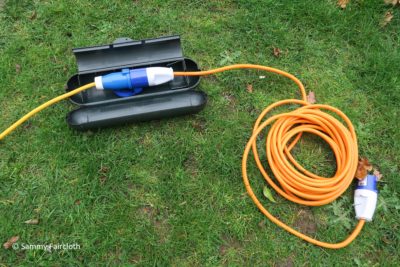
Carry a spare 10 metre cable and a weather proof plug and coupler safebox just in case your 25-metre cable does not reach.
Electrical safety in some European countries might not meet our high standards. Some hook-up points look a bit like a spaghetti junction, whilst some pitches require you to run the cable across an access road.
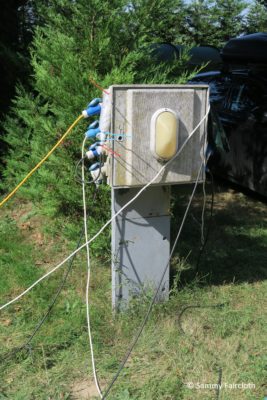
Some European hook-up points look like a spaghetti junction.
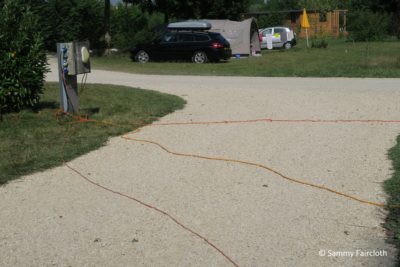
Try to avoid running your EHU cable across an access road as it may become damaged.
Always exercise caution and if you feel that the unit is not safe, then find another hook-up point or report it to the site reception. Safety is paramount!
What appliances can I use?
Most electrical appliances are rated in watts, which refer to the rate of consumption. Most modern caravans and motorhomes run from a 230 Volts AC supply (check your handbook).
To work out the maximum consumption from your hook-up unit a simple calculation can be used:
watts ÷ volts = amps OR volts x amps = watts
All electrical appliances should have a label stating their power consumption.
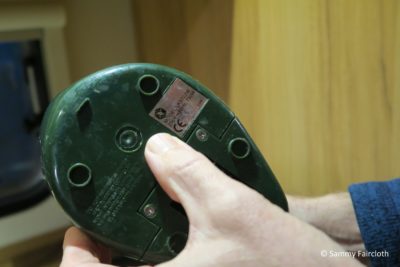
Check out the wattage of your electrical appliance to make sure you won’t trip the switch.
As an example, a typical kitchen kettle is 2200 watts. Dividing this figure by 230 volt supply gives 9.6amps. That’s about 60% of the consumption on a 16 amp electric hook-up. This is before you allow for your essential electrical appliances such as your vehicle’s water heater, lights, fridge, space heating and pumps.
It’s advisable to carry out this simple calculation before turning on all your electrical items at once. Otherwise, you might upset a few campers and the site staff when you trip out the hook-up point! Consider buying low wattage appliances, like travel kettles, which are around 750 watts.
Here’s an example of some appliances and their approximate ampage.
| Appliance | Wattage | Consumption (Amps) |
| In-built heater (3 Settings) | 2000W, 1000W or 500W | 8.7, 4.3 or 2.2 |
| Water heater | 1500W | 6.5 |
| Microwave | 1200W | 5.2 |
| Travel hairdryer | 1200W | 5.2 |
| Toaster | 800W | 3.5 |
| Travel kettle | 750W | 3.3 |
| Portable heater | 600W | 2.6 |
| Laptop charger | 391W | 1.7 |
| Fridge | 153W | 0.67 |
| Hair straighteners | 60W | 0.26 |
| Battery trickle charging | From 7W | From 0.03 |
| Water pump | Negligible | |
| Lights (depends on bulbs used) | Negligible |
Please note: These figures are based on appliances in the author’s caravan.
Electric hook-ups and insurance considerations
To protect your caravan or motorhome from risk of fire and avoid a costly caravan or motorhome insurance claim, don’t use unbranded phone and laptop chargers to power up your devices. They’ve been known to overheat and cause household fires.
Also, make sure any electric accessories which you fit to your leisure vehicle, e.g. solar panels, are suitable for leisure vehicle use; are fitted by an expert, and meet UK specification.
Over to you…
Got any electric hook up tales or advice you want to share with other readers? Feel free to share in the comments box below.


Can I link my van cable to my house mains. Or do I need a transformer.
Yes you just need an adaptor: https://www.towsure.com/mains-adapter-13-amp-plug-to-caravan-mains-socket
Hi, great site, but can you help me with a question? I want to buy a 240/12v electrical installation system for my van (the kit is available from a UK company); however I’m in Europe. While the company only supply UK power outlets (European ones being quite different of course), I wanted to ask if the European electrical system is equivalent to the UK – in other words, if I buy the kit and supply my own European outlets, will that be OK? I understand that standards and regulations probably vary from country to country, but is the hardware itself the same? I assume yes; otherwise you probably wouldn’t be able to hook up UK caravans to European sites; but I just want to be sure before I fork out 400+ quid for a kit. Would really appreciate any advice. Thanks
Very good article, for beginners. Thank you.
I constantly see cable still wound on the holder, with only the length required to connect. The owner thinking this is “neater” than completely UNWINDING from the holder, a very dangerous habit as the cable will easily overheat when the load is at, or near, the usual Max of 16 amps. PLEASE unwrap ALL cable and lay excess loosely under the MH or Caravan-as demonstrated in this very informative article
When I connect my cable to the hook up post, I wrap the cable once around the post loosely so if the cable gets pulled by a lawn mower type tractor going past or some one tripping over the cable for example, the cable will tighten on the post instead of pulling out the plug and potentially leave bare live wires.
Also, if it is due to snow, lay the cable in straight lines and to items that can’t move like a tree. If the ground freezes and the cable is frozen under the snow, it’s much easier to trace the route of the cable if it’s in straight lines vs a wiggly route. Better still is to lift the cable on a daily basis to avoid it being frozen into the ground.
Great article, as it highlighted areas we were unsure able, ie, what appliances we can take on a trip.
As a new campervan owner this article is a brilliant read – thank you
An excellent, comprehesive article. As someone who regularly helps out at a friend’s caravan park, I often I see campers leave the cable tightly coiled around the cable storer or on the ground, thus increasing the possibility of fire – an electric cable under load can act as a heating coil when tightly wound. I also see campers plugging in to the mains supply before connecting to the van – particularly dangerous on wet grass! Always, alway unwind your cable fully, and plug into the van socket first before plugging in to the mains.
Polarity check is always a good idea, especially abroad or more casual sites!
Each month we learn a bit more, great reading and sharing knowledge to us newbies.
Very good advice, although the current drawn that is shown in the chart is close to most Motorhomes double check all your equipment, very good advice regarding using genuine chargers for various equipment as I have read and seen none genuine chargers overheat. Lastly the advice regarding travel kettles that are designed to operate at low wattage rather than a kettle used for home that are designed for rapid boiling.
Good info. and well explained.